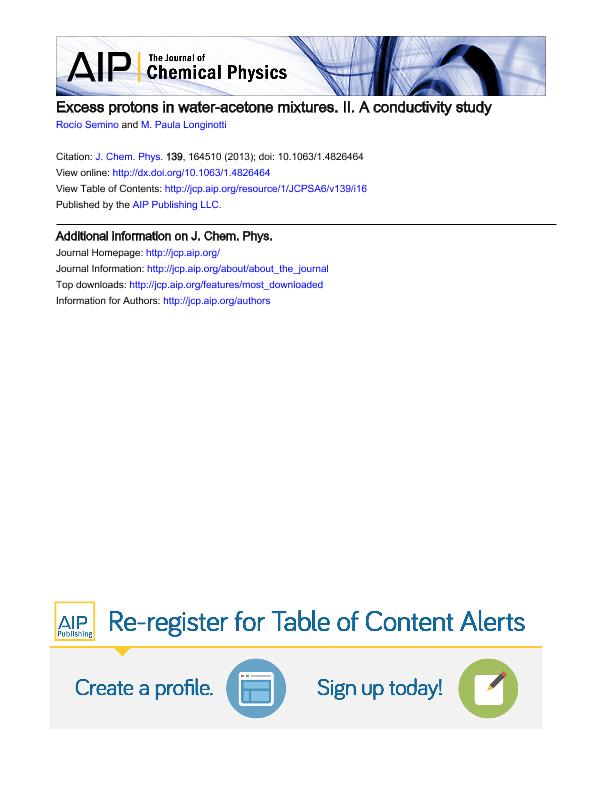Mostrar el registro sencillo del ítem
dc.contributor.author
Semino, Rocio

dc.contributor.author
Longinotti, María Paula

dc.date.available
2019-09-24T21:20:16Z
dc.date.issued
2013-10
dc.identifier.citation
Semino, Rocio; Longinotti, María Paula; Excess protons in water-acetone mixtures. II. A conductivity study; American Institute of Physics; Journal of Chemical Physics; 139; 16; 10-2013; 1-8
dc.identifier.issn
0021-9606
dc.identifier.uri
http://hdl.handle.net/11336/84351
dc.description.abstract
In the present work we complement a previous simulation study "R. Semino and D. Laria, J. Chem. Phys. 136, 194503 (2012)" on the disruption of the proton transfer mechanism in water by the addition of an aprotic solvent, such as acetone. We provide experimental measurements of the mobility of protons in aqueous-acetone mixtures in a wide composition range, for water molar fractions, xw, between 0.05 and 1.00. Furthermore, new molecular dynamics simulation results are presented for rich acetone mixtures, which provide further insight into the proton transport mechanism in water-non-protic solvent mixtures. The proton mobility was analyzed between xw 0.05 and 1.00 and compared to molecular dynamics simulation data. Results show two qualitative changes in the proton transport composition dependence at x w ∼ 0.25 and 0.8. At xw < 0.25 the ratio of the infinite dilution molar conductivities of HCl and LiCl, Λ 0HCl.Λ0LiCl-1, is approximately constant and equal to one, since the proton diffusion is vehicular and equal to that of Li+. At xw ∼ 0.25, proton mobility starts to differ from that of Li+ indicating that above this concentration the Grotthuss transport mechanism starts to be possible. Molecular dynamics simulation results showed that at this threshold concentration the probability of interconversion between two Eigen structures starts to be non-negligible. At xw ∼ 0.8, the infinite molar conductivity of HCl concentration dependence qualitatively changes. This result is in excellent agreement with the analysis presented in the previous simulation work and it has been ascribed to the interchange of water and acetone molecules in the second solvation shell of the hydronium ion.
dc.format
application/pdf
dc.language.iso
eng
dc.publisher
American Institute of Physics

dc.rights
info:eu-repo/semantics/openAccess
dc.rights.uri
https://creativecommons.org/licenses/by-nc-sa/2.5/ar/
dc.subject
Proton Transport
dc.subject
Binary Mixtures
dc.subject
Conductivity
dc.subject.classification
Físico-Química, Ciencia de los Polímeros, Electroquímica

dc.subject.classification
Ciencias Químicas

dc.subject.classification
CIENCIAS NATURALES Y EXACTAS

dc.title
Excess protons in water-acetone mixtures. II. A conductivity study
dc.type
info:eu-repo/semantics/article
dc.type
info:ar-repo/semantics/artículo
dc.type
info:eu-repo/semantics/publishedVersion
dc.date.updated
2019-06-11T18:18:38Z
dc.journal.volume
139
dc.journal.number
16
dc.journal.pagination
1-8
dc.journal.pais
Estados Unidos

dc.journal.ciudad
Nueva York
dc.conicet.avisoEditorial
This article may be downloaded for personal use only. Any other use requires prior permission of the author and AIP Publishing. This article appeared in The Journal of Chemical Physics and may be found at https://aip.scitation.org/doi/full/10.1063/1.4826464
dc.description.fil
Fil: Semino, Rocio. Consejo Nacional de Investigaciones Científicas y Técnicas. Oficina de Coordinación Administrativa Ciudad Universitaria. Instituto de Química, Física de los Materiales, Medioambiente y Energía. Universidad de Buenos Aires. Facultad de Ciencias Exactas y Naturales. Instituto de Química, Física de los Materiales, Medioambiente y Energía; Argentina
dc.description.fil
Fil: Longinotti, María Paula. Consejo Nacional de Investigaciones Científicas y Técnicas. Oficina de Coordinación Administrativa Ciudad Universitaria. Instituto de Química, Física de los Materiales, Medioambiente y Energía. Universidad de Buenos Aires. Facultad de Ciencias Exactas y Naturales. Instituto de Química, Física de los Materiales, Medioambiente y Energía; Argentina
dc.journal.title
Journal of Chemical Physics

dc.relation.alternativeid
info:eu-repo/semantics/altIdentifier/doi/http://dx.doi.org/10.1063/1.4826464
dc.relation.alternativeid
info:eu-repo/semantics/altIdentifier/url/https://aip.scitation.org/doi/10.1063/1.4826464
Archivos asociados
